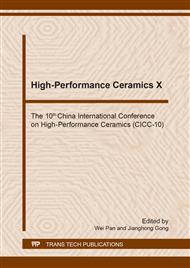[1]
C. Zhang, J. Yang, T. Qiu, J. Guo, Preparation of ZTA ceramic by aqueous gelcasting with a low-toxic monomer DMAA, Ceramics International, 38 (2012) 3063-3068.
DOI: 10.1016/j.ceramint.2011.12.004
Google Scholar
[2]
S. Huang, J.G.P. Binner, B. Vaidhyanathan, R.I. Todd, Quantitative analysis of the residual stress and dislocation density distributions around indentations in alumina and zirconia toughened alumina (ZTA) ceramics, Journal of the European Ceramic Society, 34 (2014).
DOI: 10.1016/j.jeurceramsoc.2013.09.021
Google Scholar
[3]
M. Mazaheri, A.M. Zahedi, M.M. Hejazi, Processing of nanocrystalline 8mol% yttria-stabilized zirconia by conventional, microwave-assisted and two-step sintering, Materials Science & Engineering A, 492 (2008) 261-267.
DOI: 10.1016/j.msea.2008.03.023
Google Scholar
[4]
K. Annapoorani, A. Paul, I. Santacruz, B. Vaidhyanathan, Dense nanostructured zirconia by two stage conventional/hybrid microwave sintering, Journal of the European Ceramic Society, 28 (2008) 973-977.
DOI: 10.1016/j.jeurceramsoc.2007.09.002
Google Scholar
[5]
S.-T. Oh, K.-i. Tajima, M. Ando, T. Ohji, Fabrication of porous Al2O3 by microwave sintering and its properties, Materials Letters, 48 (2001) 215-218.
DOI: 10.1016/s0167-577x(00)00306-2
Google Scholar
[6]
J. Wang, R. Stevens, Zirconia-toughened alumina (ZTA) ceramics, Journal of Materials Science, 24 (1989) 3421-3440.
DOI: 10.1007/bf02385721
Google Scholar
[7]
A.Z.A. Azhar, L.C. Choong, H. Mohamed, M.M. Ratnam, Z.A. Ahmad, Effects of Cr2O3 addition on the mechanical properties, microstructure and wear performance of zirconia-toughened-alumina (ZTA) cutting inserts, Journal of Alloys and Compounds, 513 (2012).
DOI: 10.1016/j.jallcom.2011.09.092
Google Scholar
[8]
M. Rühle, A.G. Evans, R.M. Mcmeeking, P.G. Charalambides, J.W. Hutchinson, Microcrack toughening in alumina/zirconia, Acta Metallurgica, 35 (1987) 2701-2710.
DOI: 10.1016/0001-6160(87)90269-0
Google Scholar
[9]
J. Zeng, J. Yang, W. Wan, X. Liu, T. Qiu, Effect of Al2O3 particle size on preparation and properties of ZTA ceramics formed by gelcasting, Ceramics International, 40 (2014) 5333-5338.
DOI: 10.1016/j.ceramint.2013.10.111
Google Scholar
[10]
H.L. Calambás Pulgarin, M.P. Albano, Sintering, microstrusture and hardness of different alumina–zirconia composites, Ceramics International, 40 (2014) 5289-5298.
DOI: 10.1016/j.ceramint.2013.10.102
Google Scholar
[11]
R. Vasudevan, T. Karthik, S. Ganesan, R. Jayavel, Effect of microwave sintering on the structural and densification behavior of sol–gel derived zirconia toughened alumina (ZTA) nanocomposites, Ceramics International, 39 (2013) 3195-3204.
DOI: 10.1016/j.ceramint.2012.10.004
Google Scholar
[12]
R. Benavente, M.D. Salvador, F.L. Penaranda-Foix, E. Pallone, A. Borrell, Mechanical properties and microstructural evolution of alumina–zirconia nanocomposites by microwave sintering, Ceramics International, 40 (2014) 11291-11297.
DOI: 10.1016/j.ceramint.2014.03.153
Google Scholar
[13]
T. Gu, h. Lu, Microwave sintering of Al2O3-ZrO2-WC-Co cermets, Journal of Wuhan University of Technology-Mater. Sci. Ed., 26 (2011) 289-291.
DOI: 10.1007/s11595-011-0215-3
Google Scholar
[14]
R. Heuguet, S. Marinel, A. Thuault, A. Badev, Effects of the susceptor dielectric properties on the microwave sintering of alumina, Journal of the American Ceramic Society, 96 (2013) 3728-3736.
DOI: 10.1111/jace.12623
Google Scholar
[15]
K.I. Rybakov, E.A. Olevsky, E.V. Krikun, Microwave Sintering: Fundamentals and Modeling, Journal of the American Ceramic Society, 96 (2013) 1003-1020.
DOI: 10.1111/jace.12278
Google Scholar
[16]
R.W. Rice, C.C. Wu, F. Boichelt, Hardness–Grain‐Size Relations in Ceramics, Journal of the American Ceramic Society, 77 (2010) 2539-2553.
DOI: 10.1111/j.1151-2916.1994.tb04641.x
Google Scholar


